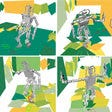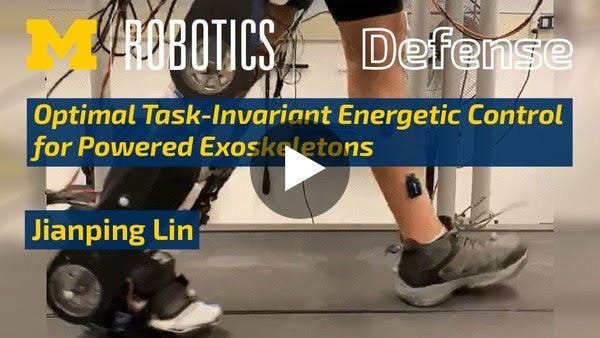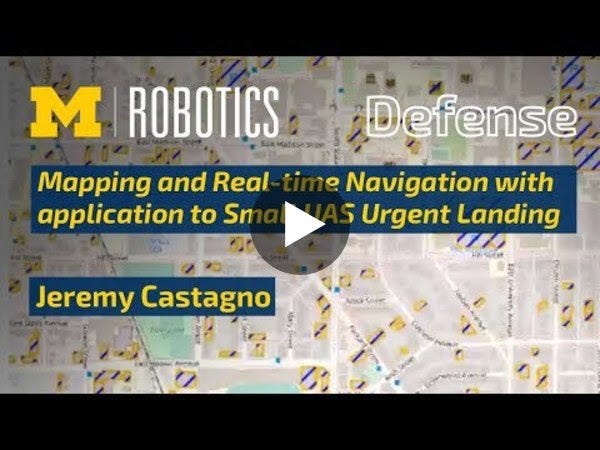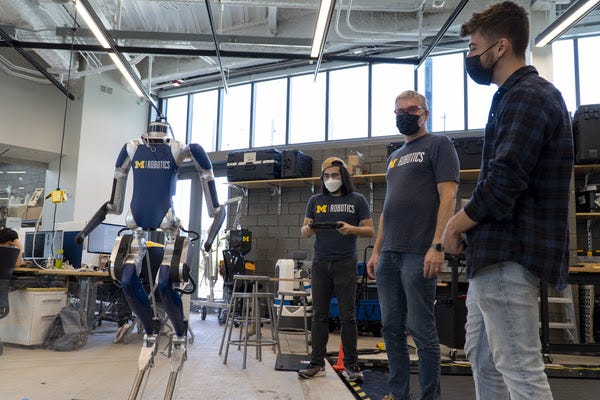The Michigan Robotics Newsletter, Fall 2021
Note: these posts were migrated from Twitter’s Revue newsletter after it shut down in January, 2023. Unfortunately links will not redirect at this time, but we hope to find some time to go through these and relink in the future.
Welcome to the Michigan Robotics Newsletter, a summary of what’s happening in the University of Michigan Robotics Institute community.
Research
Rubble-roving robots use hands and feet to navigate treacherous terrain
Yu-Chi Lin and Dmitry Berenson provide a new path planning algorithm gives a speed upgrade to rescue robots that use their arms to make their way across treacherous terrain such as disaster areas.
A model to predict how much humans and robots can be trusted with completing specific tasks
Hebert Azevedo Sá was first author on a paper explaining a bi-directional model that can predict how much both humans and robotic agents can be trusted in situations that involve human-robot collaboration.
$7.5M MURI to make dynamic AI smarter and safer
Researchers from four U.S. institutions, including Necmiye Ozay, aim to pull the best from control theory and machine learning to build safer mobile, intelligent systems.
Robots who goof: Can we trust them again?
When robots make mistakes—and they do from time to time—reestablishing trust with human co-workers depends on how the machines own up to the errors and how human-like they appear, according to Connor Esterwood and Lionel Robert.
$2M ‘robot assistants’ project aims to reinvent construction industry
With the aim of enabling robots to learn from human partners on construction sites, NSF is providing $2 million to a project led by Carol Menassa with Arash Adel, Vineet Kamat, Joyce Chai, and Wes McGee.
Improving Attitude Estimation Using Magnetic Field Maps
Prince Kuevor presents a paper that explains methods to create, validate, and visualize three-dimensional magnetic field maps to expand the use of magnetic fields as a sensing modality for navigation.
$1M for open-source first-responder robots
Tomorrow’s wildfire fighters and other first responders may tag-team with robotic assistants that can hike through wilderness areas, thanks to a project run by Maani Ghaffari and Jessy Grizzle and funded by a new $1 million grant from the NSF.
Comparison of Display Modality and Human-in-the-Loop Presence for On-Orbit Inspection of Spacecraft
Hannah Weiss and Leia Stirling published work that investigates the impact of interface displays and human-in-the-loop presence with teleoperated robotic systems onboard spacecraft.
Individual finger control for advanced prostheses demonstrated in primates
An electrode array implanted in the brain predicts finger motions in near real time, in work done by Cynthia Chestek.
$1.7M to build everyday exoskeletons to assist with lifting, walking and climbing stairs
In an effort to bring robotic assistance to workers, the elderly and more, Robert Gregg is leading work with Elliott Rouse and Mouli Krishnan to develop a new type of powered exoskeleton for lower limbs—funded by $1.7 million from NIH.
Congrats
Announcing the 2021 Robotics Outreach Ambassadors
This is an award to students who’ve gone above-and-beyond in service to the community.
IROS Best Paper to give robots more planning foresight
Alphonsus Adu-Bredu‘s paper on a new framework provides a means to help robots plan while faced with different sources of uncertainty earned the award.
AIS Introduces New Cohort of Distinguished Members
Lionel Robert, an editorial board member of the Associate of Information Science, became a 2021 Distinguished Member of the organization.
The NAE invites Ozay to symposium to advance the engineering frontier
Necmiye Ozay presented her research on learning, control, verification, and validation for safe cyber-physical systems.
Tilbury joins OVPR to lead strategy on future communities
Dawn Tilbury, who recently led the National Science Foundation’s Directorate for Engineering, has joined the Office of the Vice President for Research.
Look
Jianping Lin: PhD Defense
Jeremy Castagno: PhD Defense
Brad Saund: PhD Defense
Hebert Azevedo Sá: PhD Defense
Modelling BLDC motors for the design of lightweight robotic systems by Elliott Rouse.
Legged Robot State Estimation using IKF and Learned Contact Events with CURLY Lab.
Read
How an open door led to fulfilling a robotics dream
“I walked into your office about 5 years ago and we had a conversation that shaped my educational career.” - Victor Popa-Simil














